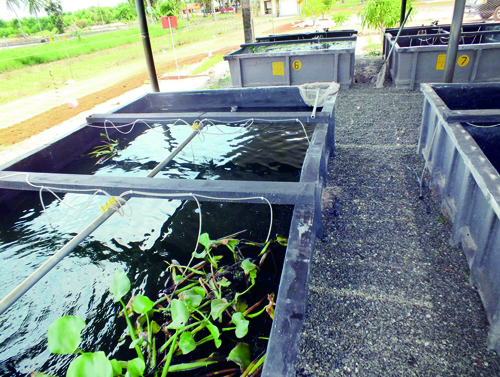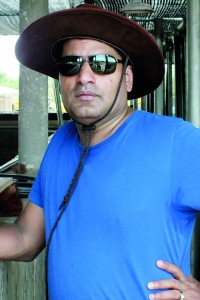Sri Lanka’s largest aquaculture project in Chilaw
View(s):Prawn farms were thriving in the vast marshes along the Puttalam lagoon when they first started in the mid-1980s and reached a climax in 1994 with owners making huge profits.
However, with the 1994 elections some of these farms were attacked and supporters of the new government set up prawn farms along the buffer zones and even government reserves.

Some varieties of fish at the farm
Due to this haphazard creation of farms and with the emergence of the ‘White Spot’ disease, the total prawn industry collapsed and with this the massive rural economy that built up in that area (through this industry) too, crashed.
Hope is now growing that this entire abandoned area could be transformed into productive aquaculture to rear different kinds of fish, particularly after Sri Lanka’s largest aquaculture project began in 2012 in Ambakandawila, Chilaw.
The aim is to promote inland fisheries across the country. Eventually the fish produced in this manner would reach the global market as ‘Sri Lanka Fish’ in the same way ‘Ceylon Tea’ is marketed.
This aquaculture industry was created due to the pioneering efforts of Dr. Senaka De Silva, Chairman, Ryder Holdings Pvt Ltd and now the Managing Director, Senura Aquaculture Project Lanka (Pvt) Ltd (SAPL).
Dr. de Silva, a sturdy soldier who served the Sri Lanka Army as an officer for 10 years with his qualifications on information technology, made a major impact on the telecommunication industry in Sri Lanka with the launch of ‘Lanka Internet’.
When the Business Times (BT) reached the country’s largest aquaculture farm in Ambakandawila on Sunday morning (18/5) this telecommunications expert-turned-aquaculture-entrepreneur wearing a leather hat and dark glasses welcomed us at his property. The initial SAPL spread over 200 acres, and on Sunday the company launched the second stage of extending it to another 100 acres.
He told the BT that it was a revolutionary initiative and the present venture was possible with innovative modern technology developed in Israel. His move to aquaculture from IT comes from the belief that the whole country could embrace inland fisheries which in turn could penetrate the rural economy in a big way.

Dr. Senaka De Silva, Managing Director, SAPL.
“Take the example of Vietnam, that country was nothing around 30 years ago but today their inland fish export figure is US$7.8 billion per year,” he said.
The company rears improved varieties of fish like Baramundy locally known as ‘Moda’, Thilapia, milk fish Vekkaya, Anndudiga Issa, cat fish, etc; that have ready markets overseas. This fish is exported mainly to Europe, Israel, Japan and the US. The company exports nearly 8 million kg of fish once in three months.
The fish are not so much prone to disease like the prawns that were affected badly, Dr. De Silva said. But he noted that they are not taking any chances and ensure the utmost care in maintaining the highest quality of the fish.
Their other concern is how far this industry could benefit the rural economy. With this in mind, he has plans to form companies in the proportion of 51 per cent (owned by him) and 49 per cent from the local community, grow the fish and adopt a buy-back system. He said that the expansion has multi-pronged benefits, such as bringing in much needed foreign exchange, a heavy boost on the economy and a higher proportion of fish to the local market which means more protein for the people.
Local conditions are ideal for expansion, he said, adding that he believes “Sri Lanka Fish” could reach the status of ‘Ceylon Tea’. More so he said because due to exploitation there is prediction that sea fish stocks would diminish in the next decade or so.
SAPL is a joint venture project between AR Aquaculture Projects, Israel and Ryder Holdings, Sri Lanka under BOI with equal funding.
Sheldon Sehreeter, Chairman, SAPL from Israel, told the BT that their novel technology in aquaculture is bound to attract many countries and many countries in Asia, Africa and South America.
He said that now all eyes are on Sri Lanka and “whether there is a global market and how Sri Lanka would emerge as an aquaculture power”. He said that countries like Thailand and Vietnam were nothing some years ago but has now reached the pinnacle of success in aquaculture.
He said that SAPL plans to launch a fish food processing plant as at present fish food is imported. He said “I think within a year there would be a lot more activity in Sri Lanka”.
There were several foreign nationals from Taiwan and Russia at the Ambakandawila SAPL farm to pick up first-hand information on how the new Israel technology is used in aquaculture.
On May 18th, the foundation stone for the expanded project was laid by Dr. Rajitha Senaratne, Minister of Fisheries. At a media briefing that followed, Dr. Senaratne elaborated on the vast strides of achievements that the fisheries industry has made in Sri Lanka.


